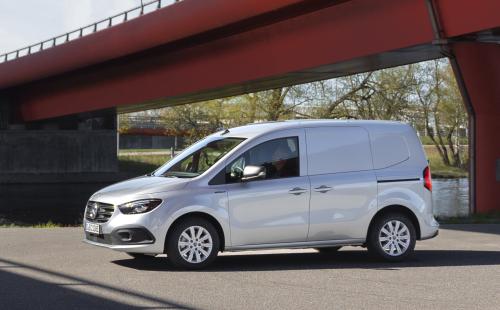
As a Tourer (combined power consumption: 19.16 kWh/100 km) for commercial passenger transport, it will initially be available as a compact version, with the long version appearing at a slightly later date. Depending on the model, the operating range is between 280 and 284 kilometers according to WLTP. This meets the needs of commercial customers who frequently use the small van models as courier, shuttle and delivery vehicles in urban areas.
At fast-charging stations, the 45 kWh battery is charged from 10 to 80% SoC within 38 minutes with the installed 80 kW DC charger. The load capacity and payload are comparable to those of the conventionally powered Citan models. For the compact panel van, this is 2.9 cubic meters and up to 544 kilograms, for the long model 3.7 cubic meters and up to 722 kilograms. Prices for the 90 kW eCitan start at around €36,000 for the compact model as a Panel Van.
The eCitan’s electric motor has a peak output of 90 kW (122 hp). The maximum torque of 245 N·m is inherently already available when starting off. This allows particularly powerful acceleration from a standing start. The lithium-ion battery is positioned in the underbody ahead of the rear axle, where it is also protected against crashes. It offers a usable capacity of 45 kWh. The eight battery modules use pouch cells.
An externally excited synchronous motor drives the front wheels of the eCitan. The synchronous motor’s rotor turns at the frequency of the stator’s magnetic field. The frequency is adapted to the speed requirements of the driver in the water-cooled frequency converters of the power electronics. Customers can choose between the Comfort and ECO (range-optimised) drive programs and three recuperation levels (D- / D / D+).
At work, at home or at public charging stations, the eCitan can be charged with alternating current (AC) at 11 kW or optionally 22 kW via the onboard charger. The time required for full charging depends on the available infrastructure and the country-specific vehicle equipment. Using a Mercedes‑Benz Wallbox allows much faster charging than at a household socket.
The eCitan also uses a heat pump to be energy efficient, reduce the power requirement and provide most of the energy for a stable vehicle range through active thermal management. The vehicle’s battery only supplies the compressor of the installed heat pump, and does not take over the actual air conditioning of the vehicle interior.
The intelligent thermal management also ensures that, when charging at a charging station, only the electricity provided there is used for pre-entry climate control. This pre-entry climate control option not only keeps the vehicle battery in the optimum operating range, but also maintains a comfortable interior temperature that is appropriate for the season. This means that the interior temperature does not have to climb to the desired level while driving, but only has to be maintained. The energy content of the vehicle battery is thus mainly available for the drive system.